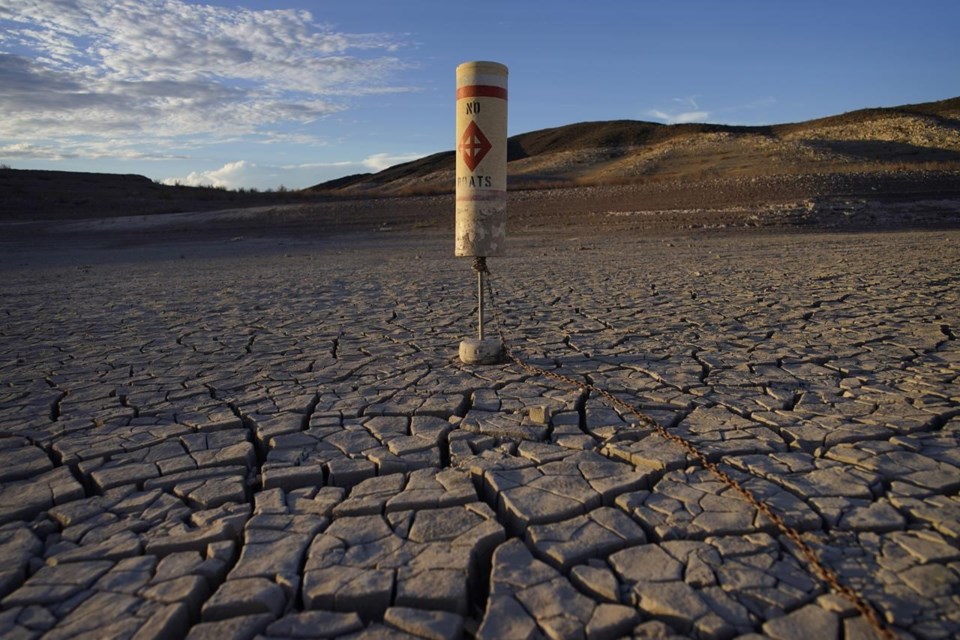LAS VEGAS (AP) — The first weeks of 2023 will be crucial for Southwest U.S. states and water entities to agree how to use less water from the drought-stricken and fast-shrinking Colorado River, a top federal water manager said Friday.
“The coming three months are absolutely critical,” U.S. Deputy Secretary of the Interior Tommy Beaudreau told the Colorado River Users Association conferees ending three-day annual meetings in Las Vegas.
“To be clear, the challenge is extraordinary,” Beaudreau said of a withering two-decade Western drought that scientists now attribute to long-term, human-caused climate change. “The science tells us it’s our new reality.”
Beaudreau closed the conference with a call for water managers, administrators and individuals throughout the West “to develop solutions to help us all address the crisis.”
The first deadline is next Tuesday, when the federal Bureau of Reclamation on an effort expected to yield a plan by summer about how to river water split among recipients in seven Western U.S. states, 30 Native American tribes and Mexico.
States have until the end of January to come to an agreement. A preliminary report is expected in the spring.
At stake is drinking water for 40 million people; for regional markets; and irrigation for farmers tilling millions of acres of former desert, producing most of the nation’s winter vegetables.
Options range from voluntary agreements among competing interests to use less, to draconian top-down federal cuts in water deliveries — perhaps affecting cities including Denver, Salt Lake City, Albuquerque, Phoenix, Los Angeles and San Diego.
The problem was demonstrated again and again since Wednesday in new data and charts at workshops and panels: into the river in the so-called Upper Basin states of Colorado, New Mexico, Utah and Wyoming than is drawn from it by the Lower Basin states of Arizona, California and Nevada.
The states share water under an interstate agreement reached 100 years ago that overestimated the amount of water the basin receives annually, mostly through snowmelt in the Rocky Mountains.
In recent years, as drought has progressed, interim agreements for Lower Basin states to share cutbacks have been enacted. Arizona farmers have been the most affected.
But unrelenting drought has dropped the river’s largest reservoirs to unprecedented low levels. Combined, Lake Mead behind Hoover Dam on the Nevada-Arizona state line and Lake Powell formed by Glen Canyon Dam on the Arizona-Utah line were at 92% capacity in 1999. Today, they are at 26%.
River water managers at the U.S. Bureau of Reclamation warn that the surface level of Lake Powell could drop so low in the next few months that intakes to could go dry.
The words “dead pool” surfaced this week as officials described the possibility that lake levels could shrink so much that neither dam would be able to release water downstream.
while ideas were floated including lining and covering canals — along with a call from the Las Vegas-area's top water manager for at least an accounting of how much water is lost to seepage and evaporation.
Most discussions, however, focused on conservation to keep water levels up at the two reservoirs.
Last month, 30 agencies that supply water to homes and businesses throughout the region joined the Las Vegas area in that no one walks on.
This week, Upper Basin states to pay farmers to fallow fields so they would need less water.
“I can feel the anxiety and the uncertainty in this room, and in the basin, as we look at the river and the hydrology that we face,” said Camille Touton, the Bureau of Reclamation commissioner with the power to act if water users don't.
“If a solution is not developed by the basin, Commissioner Touton will figure it out for us,” said U.S. Sen. Mark Kelly, a Democrat from Arizona and a former astronaut who spoke fondly Friday of his view from space of the Colorado River flowing through the Grand Canyon.
Delegates from Mexico and the International Boundary and Water Commission also were among speakers at the conference-closing at the Caesars Palace resort on the Las Vegas Strip.
“There are a lot of questions; the what, the how,” Touton said, before ending — using Spanish and then English — with encouragement to, “let’s get this done together.”
Ken Ritter, The Associated Press




